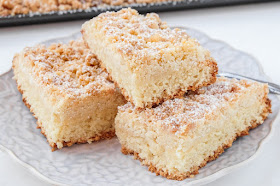 |
| A streusel coffeecake. |
Twenty some years ago, I served my now in-laws the first meal I had ever prepared for them. It was brunch, and I had called my grandmother to acquire the family's "crumb cake" recipe, that I could serve it to my prospective future family. To my surprise and delight, my now father-on-law walked in the door (the house entered directly into the kitchen), saw the pretty unassuming cake on the table, and said, eyes alight, "Oh! That's a Streuselkuchen. My mother used to make that."
I don't think I need to explain my delight at this reaction, but my surprise was due to the fact that these two families, from very different cultural background, made this same dessert. The family from whom the recipe derived is actually my step-father's family (everyone to whom I am related to by blood has much more humble roots), and they are of English descent, long settled in the United States, and deeply entrenched in Philadelphia society. My husband's paternal family is very German, immigrated to the US in the late 19th century, and settled in Kentucky. I found it further perplexing because my grandmother claimed the family had been making it since the 18th century.
Sometimes, family lure gets exaggerated. The so-called "crumb cake" (which I almost always refer to as a coffeecake, for that is what it more resembles, the streusel topping not being as heavy as your typical crumb cake) cannot be an authentic 18th century recipe because it uses baking powder as a rising agent, which wasn't invented until the mid-19th century. It also calls for crisco, first marketed by Proctor & Gamble in 1910, but, obviously, this could have been a one to one replacement for lard (I use all butter). The baking powder is the big red flag. Could a very similar cake have been made by the family using different ingredients before this time? Yes, but the history of the coffee cake in the United States suggests otherwise.
Though my British friends look at me like a lunatic when I explain that "coffeecake" doesn't typically have any coffee in it, like so many other labels (ie soccer), the term originated in England but then fell out of use there, while remaining part of the American lexicon. These early confections, like our modern versions, did not contain any coffee, but, much like tea cakes, were intended to accompany hot beverages. With the advent of chemical leavening agents in the 1840s to 1860s, they became the de facto ingredients in coffeecakes, which were distinguished by the speed of their preparation. The recipes for these early versions are very much like the one passed down from my grandmother.
 |
| Streuselkuchen. |
One of the neatest things about having relocated to "the old world" is learning more about the origins of the food we eat in the United States. It's fascinating, the journey food takes, as it is reinvented in the melting pot and influenced by technology.
Anyway, here is the "Crumb Cake" recipe, supposedly an 18th century Radford family secret. It is so much like a thousand other recipes you can find online, but this one is tried, true, easy, and delectable. My sister and uncle both modify it to make it more akin to a proper crumb cake, doubling the amount of topping and, as a result, reducing the quantity of cake, but I prefer the original proportions, which is why I almost always describe it as a coffeecake. As mentioned, I substitute the crisco for butter, and especially here in Switzerland, where the butter has a higher fat content than in the US, this results in a much longer cooking time (an additional 15-20 minutes). I also sometimes make these as cupcakes, which my daughter loves, and which conveniently reduces the cooking time. If you bake this at home, please let me know how it turns out, and do please call it an 18th century recipe, even if it isn't one, because the heritage, though exaggerated, is part of the fun.
For more information on the history of coffeecake, I highly recommend this article by Gil Marks, upon which I heavily relied in the writing of this post: https://toriavey.com/toris-kitchen/sour-cream-coffeecake-history-recipe/.
 |
| Cupcake version of the family recipe. |
- 3 cups flour
- 2 cups sugar
- 1/2 cup cold butter
- 1/2 cup Crisco
- 1 tablespoon baking powder
- 1/2 teaspoon salt
- 2 eggs, beaten
- 1 cup whole milk
- ground cinnamon
- Preheat oven to 350.
- Grease and flour two round cake pans.
- Mix all dry ingredients in a large bowl.
- Work in butter and crisco with a pastry cutter or fingers until the mixture is lumpy.
- Remove one cup of the mixture. Add cinnamon to taste and set aside for topping.
- Beat the eggs and milk together in a separate bowl.
- Add liquid ingredients to the dry in two stages.
- Pour into prepared pans.
- Sprinkle crumb topping over the batter.
- Bake for 30 minutes or an inserted toothpick comes out clean. The cake will be set and slightly browned.

Streusel! That's the word I was missing. Thank you for a great post and the recipe, Alexa!
ReplyDeleteSounds delicious
ReplyDelete